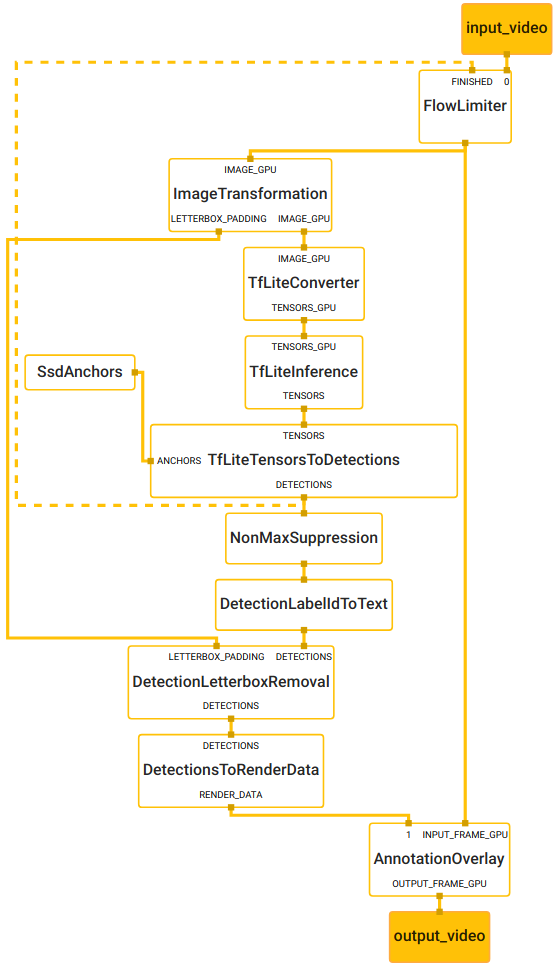7.6 KiB
7.6 KiB
Face Detection (GPU)
This doc focuses on the example graph that performs face detection with TensorFlow Lite on GPU.
Android
To build and install the app:
bazel build -c opt --config=android_arm64 mediapipe/examples/android/src/java/com/google/mediapipe/apps/facedetectiongpu
adb install bazel-bin/mediapipe/examples/android/src/java/com/google/mediapipe/apps/facedetectiongpu/facedetectiongpu.apk
iOS
See the general instructions for building iOS examples and generating an Xcode project. This will be the FaceDetectionGpuApp target.
To build on the command line:
bazel build -c opt --config=ios_arm64 mediapipe/examples/ios/facedetectiongpu:FaceDetectionGpuApp
Graph
To visualize the graph as shown above, copy the text specification of the graph below and paste it into MediaPipe Visualizer.
# MediaPipe graph that performs face detection with TensorFlow Lite on GPU.
# Used in the examples in
# mediapipie/examples/android/src/java/com/mediapipe/apps/facedetectiongpu and
# mediapipie/examples/ios/facedetectiongpu.
# Images on GPU coming into and out of the graph.
input_stream: "input_video"
output_stream: "output_video"
# Throttles the images flowing downstream for flow control. It passes through
# the very first incoming image unaltered, and waits for
# TfLiteTensorsToDetectionsCalculator downstream in the graph to finish
# generating the corresponding detections before it passes through another
# image. All images that come in while waiting are dropped, limiting the number
# of in-flight images between this calculator and
# TfLiteTensorsToDetectionsCalculator to 1. This prevents the nodes in between
# from queuing up incoming images and data excessively, which leads to increased
# latency and memory usage, unwanted in real-time mobile applications. It also
# eliminates unnecessarily computation, e.g., a transformed image produced by
# ImageTransformationCalculator may get dropped downstream if the subsequent
# TfLiteConverterCalculator or TfLiteInferenceCalculator is still busy
# processing previous inputs.
node {
calculator: "FlowLimiterCalculator"
input_stream: "input_video"
input_stream: "FINISHED:detections"
input_stream_info: {
tag_index: "FINISHED"
back_edge: true
}
output_stream: "throttled_input_video"
}
# Transforms the input image on GPU to a 128x128 image. To scale the input
# image, the scale_mode option is set to FIT to preserve the aspect ratio,
# resulting in potential letterboxing in the transformed image.
node: {
calculator: "ImageTransformationCalculator"
input_stream: "IMAGE_GPU:throttled_input_video"
output_stream: "IMAGE_GPU:transformed_input_video"
output_stream: "LETTERBOX_PADDING:letterbox_padding"
node_options: {
[type.googleapis.com/mediapipe.ImageTransformationCalculatorOptions] {
output_width: 128
output_height: 128
scale_mode: FIT
}
}
}
# Converts the transformed input image on GPU into an image tensor stored as a
# TfLiteTensor.
node {
calculator: "TfLiteConverterCalculator"
input_stream: "IMAGE_GPU:transformed_input_video"
output_stream: "TENSORS_GPU:image_tensor"
}
# Runs a TensorFlow Lite model on GPU that takes an image tensor and outputs a
# vector of tensors representing, for instance, detection boxes/keypoints and
# scores.
node {
calculator: "TfLiteInferenceCalculator"
input_stream: "TENSORS_GPU:image_tensor"
output_stream: "TENSORS:detection_tensors"
node_options: {
[type.googleapis.com/mediapipe.TfLiteInferenceCalculatorOptions] {
model_path: "face_detection_front.tflite"
}
}
}
# Generates a single side packet containing a vector of SSD anchors based on
# the specification in the options.
node {
calculator: "SsdAnchorsCalculator"
output_side_packet: "anchors"
node_options: {
[type.googleapis.com/mediapipe.SsdAnchorsCalculatorOptions] {
num_layers: 4
min_scale: 0.1484375
max_scale: 0.75
input_size_height: 128
input_size_width: 128
anchor_offset_x: 0.5
anchor_offset_y: 0.5
strides: 8
strides: 16
strides: 16
strides: 16
aspect_ratios: 1.0
fixed_anchor_size: true
}
}
}
# Decodes the detection tensors generated by the TensorFlow Lite model, based on
# the SSD anchors and the specification in the options, into a vector of
# detections. Each detection describes a detected object.
node {
calculator: "TfLiteTensorsToDetectionsCalculator"
input_stream: "TENSORS:detection_tensors"
input_side_packet: "ANCHORS:anchors"
output_stream: "DETECTIONS:detections"
node_options: {
[type.googleapis.com/mediapipe.TfLiteTensorsToDetectionsCalculatorOptions] {
num_classes: 1
num_boxes: 896
num_coords: 16
box_coord_offset: 0
keypoint_coord_offset: 4
num_keypoints: 6
num_values_per_keypoint: 2
sigmoid_score: true
score_clipping_thresh: 100.0
reverse_output_order: true
x_scale: 128.0
y_scale: 128.0
h_scale: 128.0
w_scale: 128.0
min_score_thresh: 0.75
}
}
}
# Performs non-max suppression to remove excessive detections.
node {
calculator: "NonMaxSuppressionCalculator"
input_stream: "detections"
output_stream: "filtered_detections"
node_options: {
[type.googleapis.com/mediapipe.NonMaxSuppressionCalculatorOptions] {
min_suppression_threshold: 0.3
overlap_type: INTERSECTION_OVER_UNION
algorithm: WEIGHTED
return_empty_detections: true
}
}
}
# Maps detection label IDs to the corresponding label text ("Face"). The label
# map is provided in the label_map_path option.
node {
calculator: "DetectionLabelIdToTextCalculator"
input_stream: "filtered_detections"
output_stream: "labeled_detections"
node_options: {
[type.googleapis.com/mediapipe.DetectionLabelIdToTextCalculatorOptions] {
label_map_path: "face_detection_front_labelmap.txt"
}
}
}
# Adjusts detection locations (already normalized to [0.f, 1.f]) on the
# letterboxed image (after image transformation with the FIT scale mode) to the
# corresponding locations on the same image with the letterbox removed (the
# input image to the graph before image transformation).
node {
calculator: "DetectionLetterboxRemovalCalculator"
input_stream: "DETECTIONS:labeled_detections"
input_stream: "LETTERBOX_PADDING:letterbox_padding"
output_stream: "DETECTIONS:output_detections"
}
# Converts the detections to drawing primitives for annotation overlay.
node {
calculator: "DetectionsToRenderDataCalculator"
input_stream: "DETECTIONS:output_detections"
output_stream: "RENDER_DATA:render_data"
node_options: {
[type.googleapis.com/mediapipe.DetectionsToRenderDataCalculatorOptions] {
thickness: 10.0
color { r: 255 g: 0 b: 0 }
}
}
}
# Draws annotations and overlays them on top of the input images.
node {
calculator: "AnnotationOverlayCalculator"
input_stream: "INPUT_FRAME_GPU:throttled_input_video"
input_stream: "render_data"
output_stream: "OUTPUT_FRAME_GPU:output_video"
}

